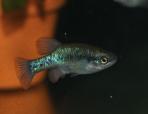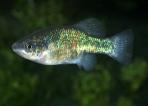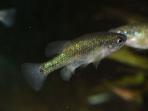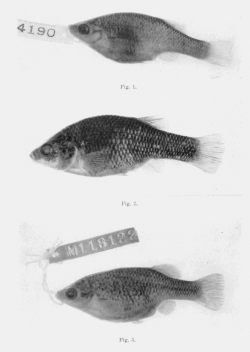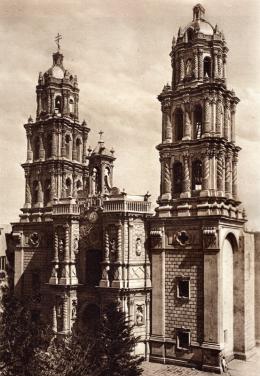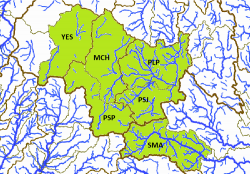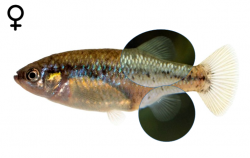Xenoophorus captivus
HUBBS, C. L. (1924): Studies of the Fishes of the Order Cyprinodontes. V. Notes on Species of Goodea and Skiffia. Occasional Papers of the Museum of Zoology University of Michigan No 148: pp 1-8
Collection-number: Field Museum of Natural History, Cat. No. FM-5557.
The Holotype is an adult male of 46mm standard length, collected by S. E. Meek in 1907. Clark Hubbs described the species after individuals Meek erronously addressed as Goodea atripinnis. Together with the Holotype numerous Paratypes were taken and Hubbs selected additonally to the Holotype five males of standard lengths between 40 and 45mm and five females between 45 and 49mm for the description. Concerning the description of X. erro and exsul go to the chapter "Remarks".
The left pictures shows a female Paratype of Xenoophorus captivus (Fig.1) and the Holotypes of X. erro (Fig.2) and X. exsul (Fig.3), the right picture the Cathedral of San Luis Potosí around the time when Meek was there. The type locality of the Relict Splifin is just a few kilometres S of this city:
Concerning the Holotype, Hubbs cited Meek in the description: "There is a small stream at Jesus Maria which belongs to the Río Pánuco system. It is almost without water during the dry season. At the Hacienda a dam is built across the narrow valley forming above it a small lake. In this four species of fishes were taken,...".
This small stream is an affluent of the Rìo Santa María, a tributary of the Río Tamuín, which is part of the Río Pánuco drainage in the federal state of San Luis Potosí.
The species name is derived from the Latin verb "capere" which means "to take" or "to seize". The Participle "captus" means "captured" and the noun "captivus" can be translated with "captive" or "prisoner". Hubbs didn't explain, why he had chosen that epithet, but he wrote about the habitat in the original description: "...from which [Goodea atripinnis] it has doubtless been derived by isolation following stream capture. The type-specimens come from one of those tributaries of the Rio Panuco which are known to have extended their course backward until they have drained what was formerly a part of the Lerma System." Here Hubbs points on a phenomenon called stream capture, meaning in this special case, that the Río Santa María was originally a tributary of the Río Lerma, but was redirected by geological events and became that way with all its inhabitants part of the Río Pánuco drainage.
The genus Xenoophorus was erected by C. L. Hubbs and C. L. Turner (in Turner, 1937) "primarily on the basis of ovarian and trophotaenial characters". The generic name is derived from the ancient Greek. The word ξένος (xénos) means strange and ᾠόν (óón) is the Greek term for egg. To carry something or to bear something is φόρος (phóros) in Greek, and together with the word egg it simply means "ovary". Xenoophorus can therefore be translated with "a strange type of ovary".
Goodea atripinnis Meek, 1907 (partially, for specimens from Jesus Maria)
Goodea captiva Hubbs, 1924
Xenoophorus erro Turner, 1937
Xenoophorus exsul Hubbs & Turner, 1939
The Relict Splitfn is endemic to the Mexican federal state of San Luis Potosí. It is historically known from the headwaters of the Río Santa María (Río Pánuco drainage) to about 15km below the town of Santa María del Río, including its main source, the Río Altamira and the Río Villela (Río Tierra Quemada) that merges into the Río Santa María right below Santa María del Río. It furthermore occurs in spring areas of an endorheic river (Río Matehuala) about 70km N of the city of San Luis Potosí, especially in the springs in Venado and Moctezuma, and it was also known to inhabit the endorheic springs at Illescas that dried up in 1996 (Artigas-Azas, pers.com.). According to three separate drainages, three subpopulations can be distinguished: The Río Santa María subpopulation (type subpopulation), the Río Matehuala subpopulation from Venado and Moctezuma and the Illescas subpopulation, that inhabited the endorheic springs near Illescas and which is regarded Extinct in the Wild. The bold names are the ones officially used by the Instituto Nacional de Estadística y Geografía; nevertheless, other ones might be more often in use or better known and therefore prefered.
ESU ist short for Evolutionarily Significant Unit. Each unit expresses an isolated population with different genetic characteristics within one species. ESU's can be defined by Molecular genetics, Morphology and/or Zoogeography and help in indicating different phylogenetic lineages within a species. The abbreviation for an ESU is composed of three letters of the genus, followed by the first two letters of the species name and an ongoing number in each species.
In Xenoophorus captivus, we are able to distinguish three different ESU's corresponding with the three distribution centers of the species. Xenca1 encompasses fish from the headwaters of the Río Santa Maria about Santa Maria del Río including the type location at Jesus Maria and the Río Tierra Quemada. Xenca2 is short for the extirpated in the wild fish from the former manantiales de Illescas, whereas Xenca3 for the fish from the headwaters of the endorheic Río Matehuala-drainage (with the manantiales Venado, Agua de Enmedio and Moctezuma).
The left map shows the Río Tamuín (RT) basin from the Hydrographic Region Pánuco and the Presa San José-Los Pilares y otras (JP), the San Pablo y otras (PA) and the Fresnillo-Yesca (FY) basins from the Hydrographic Region El Salado on a Mexico map. The right map shows the subbasins the species is or was able to find. No records are available from the San Pablo y otras basin, means the Mesa Chiquihuitillo (MCH) and the Presa San Pablo (PSP) subbasins, but the distribution pattern of the species makes it very likely that it once was populated. The distribution of the Relict Splitfin within the Fresnillo-Yesca basin was restricted to the Yesca subbasin (YES), where it became extinct at the end of the 1990's when the water of the system was used for agriculture and pumped down. The population (ESU: Xenca2) was luckily rescued and survives in aquariums. The species still occurs in the endorheic presas Los Pilares (PLP) and San José (PSJ) subbasins of the Presa San José-Los Pilares y otras basin (ESU Xenca3) and the Río Santa María Alto (SMA) subbasin of the Río Tamuín basin, Hydrographic Region Pánuco (ESU Xenca1):
International Union for Conservation of Nature (IUCN): Endangered
Distribution and current conservation status of the Mexican Goodeidae (Lyons et al., 2019): Endangered/declining: „The distribution and abundance of this species has shrunk considerably since the 1970’s and 1980’s owing to groundwater pumping and spring diversions that have lowered water levels and degraded water quality. Of the three ESUs, Xenca1 is critically endangered. Two or three small and somewhat interconnected populations are known from the upper portion of the Santa María del Río drainage in the upper portion of the Pánuco River basin in southern portion of the state of San Luis Potosí. Xenca2 is extinct in the wild. Historically it was found in the endorheic Illescas spring system near the border of the states of Zacatecas and San Luis Potosí, with the last confirmed collection from 1994 (Artigas-Azas, 1995). A few captive populations exist in Mexico, the United States, and Europe. Xenca3 is endangered. Populations were known from three small springs, Venados, Moctezuma, and Agua de Enmedio, located in a small endorheic basin in the northern part of San Luis Potosí. These three populations still exist but are small.“
NOM-059-SEMARNAT-2010: Categoría de riesgo (Category of risk): P - En Peligro de Extinción (in danger of extinction)
The habitats are springs and their outflows, small streams and ditches. This species lives over substrates of silt, mud, clay, sand, gravel and rocks in clear to murky water. It prefers depths of less than 1m with currents slight to moderate. Aquatic vegetation is comprised of the ubiquitous green algae and Lemna, Eichhornia, Ceratophyllum, Nasturtium and Potamogeton. Concerning water temperatures, there are given different details, correlated with different habitats. Lundell et al. (1934) reported a cold mountain stream (Agua del Medio) and cold habitats near Venado and Moctezuma, whereas Fitzsimons reported in 1979 many springs with "for reproduction convenient temperatures".
On a survey of the GWG to the Matehuala area in 2014, the group found this species in Venado, where it shared the habitat with non native Green Swordtails. The biotope was a very shallow creek with swift current. Few patches of Hydrocotyle and riparian grass gave shelter for the fish, and while the Poeciliids inhabited the riverbed, the Relict Splitfins were hiding in this dense riparian vegetation. The spring fed creek in Moctezuma was partly deeper with big patches of submerse vegetation comprised of different species. Xenoophorus captivus was the only fish species occuring on this place.
Underwater-Videos:
Indicated from collections, the reproduction period seems to extend from February to July. In populations inhabiting warm springs, young may be born year-round (Fitzsimons, 1979).
Inferred from a convoluted intestine and incisor-like teeth in the outer row, Xenoophorus captivus is a species with vegetarian feeding habits.
The colour of the Relict Splitfin is grey to brown, throat and venter are lighter. The paired fins are clear, the unpaired clear to grey, the caudal fin with a thin white to yellowish terminal band, easier visible in dominant males. The scales on the flankes and the caudal peduncle are shiny green, greenish blue or bluish. Both sexes show a midlateral dusky band which may become distinct on the opercle and the caudal peduncle of males in some populations, but is usually superimposed by green shiny scales. Few dark spots or blotches on the flankes may occur.
At first appearance, males and females of the Relict Splitfin are not very easy to distinguish. The safest characteristic is the Splitfin in males, means the for Goodeinae typical mating organ formed by a notch after the first seven shortened rays of the Anal fin. Additionally, male Xenoophorus captivus have a bigger Dorsal fin than females. A difference in colouration is almost not visible.
Hubbs and Turner planned a comprehensive publication about Goodeids, but this paper was delayed and another one from Turner about Trophotaenia (1937) was published earlier. In this paper, Turner mentioned Xenoophorus erro and declared, that "the paper with the characterizations for the various genera and species are taken will be published in the near future". So this paper however is valid as description, though "it is doubtful whether the species is recognizably differentiated in Turner 's account (Hubbs and Turner, 1939)". Then finally in 1939, the delayed paper from Hubbs and Turner was released, delivering in addition the description of Xenoophorus erro and comprising the description of a third species: Xenoophorus exsul. Both species differ marginally, mainly in size and shape of the head, and even Hubbs and Turner conceded that both species might only be subspecies after more detailed studies. The first species with the Holotype being an adult female of 49mm standard length (Cat. No.: UMMZ-108555) and numerous Paratypes was collected by Myron Gordon, Joe Whetzel and John Ross in the Río Santa María at Santa María del Río on March the 21st, 1932. The epithet they had chosen, "erro", is derived from the Latin verb "errare", meaning "to wander" or to "go astray". Following Charlton Thomas Lewis (An Elementary Latin Dictionary) from 1890, the noun "erro" has the denotation of "wanderer" or "vagabond", which was the idea Hubbs and Turner had, when they chose the species' name: "The species is named erro, wanderer, because it occurs outside the Río Lerma system, which is the center of abundance for the family".
The third species, Xenoophorus exsul, was described after a female Holoytpe of 45mm standard length (Cat. No.: UMMZ-118122), collected by the US American botanist Cyrus Longworth Lundell et al. together with numerous Paratypes on July the 21st, 1934, in Agua del Medio, and more Paratypes collected by the same party on July the 11th in Venado and July the 20th in Moctezuma. All of these habitats are located in the endorheic basin of Matehuala. The species' epithet is again derived from the Latin. The noun "exsul" means a banished person, a wanderer or exile. Hubbs and Turners comment on the choice: "The name exsul, exile, refers to the lonely occurrence of the species beyond the ancestral territory of the family". Finally all names chosen for species of the genus Xenoophorus have something to do with the phenomenon of stream capture, leading to "a prisoner, a vagabond and an exile". However, all the differences between the populations are within the morphological variety of one species and it is clear meanwhile that only Xenoophorus captivus is valid.
Looking on the biotopes of Xenoophorus captivus, they suggest the species may prefer a habitat with moderate to swift current, structured with rocks, roots and areas with dense submerse vegetation. Intraspecific aggession usually can't be observed, nevertheless structures to prevent the fish from seeing each other permanently is helpful. Fry is rarely eaten, so normally it is easy to get fast a big and flock breeding colony.
The recommended tank size is at least 150 liters, bigger tanks with a generous base and little height (25cm are enough) are better for sure. A bit with roots and/or rocks structured tanks with patches of dense submerse vegetation in the corners and bigger free areas to swim seem to do best with this species. The current should be swift to moderate, especially as the oxygene level should be quite high (at least 8mg/l).
In the wild, adults of this species feed mainly from algae and aufwuchs, so much light to help algae grow and feeding with vegetables and additionally fiber-rich middle sized food from animalistic sources will be best for this fish. In aquarium, it feeds very well from flake food, granulate and tablets, additionally freeze dried food like Brine Shrimps is eaten greedy. The species is anything else but shy.
Concerning water quality, this species is in need of bigger water changes (60-80% every week) like most of the Goodeids, especially spring and river inhabiting species. Therefore an automatic water changing system can be helpful. Otherwise, in combination with constant temperatures higher than 25°C, fish may get sick, lose resistance against diseases and age too fast. So for keeping the strain healthy and strong, and for regulating the number of fry, give the fish a rest during winter time with temperatures lower than 20°C for 2 or 3 months so they stop producing fry. In spring, when the temperature slowly increases, they will start spawning at 20 or 21°C and won't stop until it gets colder again or when it gets too warm (28°C).
This species does very well when is kept in the open from spring to fall, starting when the water temperature by day exceeds 15°C and cold periods are no longer expected. Bring them out in the early afternoon, the time of the day with the highest water temperature. During the warm summer, reproduction will stop and may occur again in fall. Bring the fish in before the water temperature deceeds 15°C by day and keep them cool for the first days, then slowly raise the temperature but try to stay below 20°C over the winter time.
Here each species are assigned populations of fish in husbandry and in brackets aliases of these locations to assist in identifying own stocks. Each population is assigned a unique Population-ID, composed by the ESU, the subbasin where this population is occurring (three capital letters) and a unique location identifier.
Populations in holding:
1. Xenca1-SMA-Bled
Population: Bledos (aka Arroyo Zapata)
Hydrographic region: Pánuco
Basin: Río Tamuín
Subbasin: Río Santa María Alto
Locality: Arroyo Zapata, around 500m Wof Bledos, San Luis Potosí
2. Xenca1-SMA-RSMar
Population: Santa María
Hydrographic region: Pánuco
Basin: Río Tamuín
Subbasin: Río Santa María Alto
Locality: Río Santa María at Santa María del Río
3. Xenca1-SMA-JMar
Population: Jesús María
Hydrographic region: Pánuco
Basin: Río Tamuín
Subbasin: Río Santa María Alto
Locality: Jesús María dam, about 19km S of San Luis Potosí
4. Xenca2-YES-Iscas
Population: Illescas
Hydrographic region: El Salado
Basin: Fresnillo-Yesca
Subbasin: Yesca
Locality: spring area S of Illescas, about 70km E of Fresnillo
5. Xenca3-PLP-Ven
Population: Venado
Hydrographic region: El Salado
Basin: Presa San José-Los Pilares y otras
Subbasin: Presa Los Pilares
Locality: spring area at W-end of Venado
6. Xenca3-PLP-Moc
Population: Moctezuma
Hydrographic region: El Salado
Basin: Presa San José-Los Pilares y otras
Subbasin: Presa Los Pilares
Locality: spring area at W-end of Moctezuma









